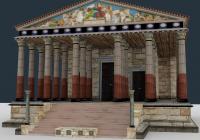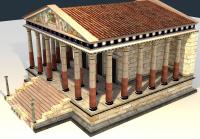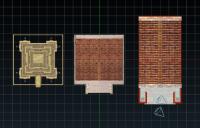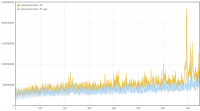Leaderboard
Popular Content
Showing content with the highest reputation on 2014-09-17 in all areas
-
3 points
-
3 points
-
I've imported some meshes and copied some stuff from them, too Thats the footprint of the hanging gardens (left), my model (middle) and the big roman temple (right): As you see, it's almost square. I've changed a lot of stuff, so some more screens: There are still the doors missing. And the temple has on all pics a bronce statue of Jupiter on the top of it. I'll have to model it, too.1 point
-
Hey Tobi that's a nice start! My suggestions are: -----General - This building is going to be a wonder, don't be afraid of polycount, go for some good looking detail. - It'll be very useful to import a wonder or the big pyramid of the game into blender, so you can have a reference of the scaling in relation with the game world and the max footprint size. - As the above suggestion, importing a unit mesh will help you to control the scale of stair steps, windows, doors etc. -----Specific - At first impression it looks a little bit small, judging by the space between the columns. - Go for a wider staircase like the reference in your 2nd post, later in the road you can put two free standing columns at the entrance of the staircase like in the reference, it'll look nice. - If you want to save work&time, you can use some existing geometry for the columns: The macedonian building set have columns with corinthian capitels and basis already done, you'll just need to remap with the roman texture. Here's a helper if you want to do it from scratch by yourself: http://upload.wikimedia.org/wikipedia/commons/5/53/Schema_Saeulenordnungen.jpg - The angle of your render may be deceiving, but it looks like it should have a more squarish plant instead of a rectangle, but as I said it may be the angle. I'm going to repeat myself, but learning how to import/export 0AD assets to is a must if you want to test them out in-game and being able to reuse geometry and assets. The introduction of this post describes the steps to import the .dae assets into blender: http://www.wildfiregames.com/forum/index.php?showtopic=17542 Don't hesitate to ask any questions and doubts you may have about the engine and/or import/export process as well as blender help if you need it!1 point
-
...at least 90% of your troops will and CAN go. Before it was more of a problem of having enough space because formations could and did spend 20 minutes at a time just trying to get around an isolated house. now you can send most of your units forth and look for stragglers to micro to the objective manually.1 point
-
I would love to see a training ground... the Romans used them too, you know1 point
-
I've made some more performance measurements. I wanted to answer the following questions: 1. What effect does GGC (Generational Garbage Collection) currently have on performance and memory usage 2. What has changed performance-wise since the first measurements in this thread? There have been many changes on 0 A.D., including Philip's performance improvements and AI changes. There have also been some changes in SpiderMonkey since that measurement and in our SpiderMonkey related code. All that could have changed the relative performance improvement directly or indirectly. 3. Have the first measurements been accurate and can they be confirmed again? Based on the experience from the Measurement and statistics thread I suspected that parts of the results could be slightly different if measured again. I didn't expect that difference to be greater than 3% at a maximum, but I wanted to confirm that and get some more accurate numbers by increasing the number of measurements and reducing the effects of other processes running on the system. 4. One mistake I've made in the first measurement was to measure v24 with C++03 and v31 with C++11. I wanted to know how much of the improvement is related to SpiderMonkey and how much to C++11. The measurement conditions were again: r15626, 2vs2 AI game on "Median Oasis (4)", 15008 turns Each measurements was executed 50 times on my notebook by a scirpt (except the v24/C++11 measurement which was executed 100 times). I've posted the distribution graphs just to give a better idea of how close these measurements are in addition to the standard deviation value. SpiderMonkey 24 with C++03 Average: 662.04 s Median: 662 s Standard deviation: 1.68 s Distribution graph of the measured values: SpiderMonkey 24 with C++11 Average: 662.43 s Median: 662 s Standard deviation: 2.47 s Distribution graph of the measured values: It was quite surprising to me that C++11 apparently didn't improve performance at all. At least it didn't get worse either. I have to say that this probably depends on the compiler a lot and I was using a relatively old GCC version which might not be able to take full adavantage of C++11 yet. SpiderMonkey 31, no GGC Average: 661.08 s Median: 661 s Standard deviation: 1.44 s Distribution graph of the measured values: SpiderMonkey 31, GGC Average: 659.94 s Median: 660 s Standard deviation: 1.48 s Distribution graph of the measured values: Memory usage graphs (only from 1 measurement each, comparing v31 and GGC with v24): We see that the average and median values are lower for v31 compared to v24 and for GGC compared to no GGC. However, the difference is so small that it could also be conincidence. That's disappointing because even though the difference in the first measurement was small too, I've hoped for a bigger improvement because of GGC. We don't quite know if the first measurement was conincidence or if some of the changes made the difference smaller again. The memory graphs look quite promising. With GGC there's quite a big decrease in memory usage. Here it's also important to note that this improvement did not have a negative impact on performance. We could have achieved a similar improvement by increasing the garbage collection frequency, but this would have had a bad impact on performance. The additional minor GCs that run between full GCs don't seem to be a performance problem. SpiderMonkey 31, GGC, keepJIT code Average: 572.98 s Median: 573 s Standard deviation: 3.72 s Distribution graph of the measured values (there was probably a background job or something running... the standard deviation is a little bit higher than for the other measurements): So far we have not seen significant performance improvements. Fortunately the impact of SpiderMonkey's problem with garbage collection of JIT code could be confirmed. It's approximately a ~13.5% improvement in this case. There's an additional problem with incremental GC, but I didn't measure that because it's quite hard to setup conditions that reflect the performance of a real fix of this bug. Anyway, "KeepJIT" means I've set the flag "alwaysPreserveCode" in vm/Runtime.cpp from false to true. It causes SpiderMonkey to keep all JIT compiled code instead of collecting it from time to time. Just setting that flag would be kind of a memory leak, so it's only valid for testing. However, SpiderMonkey's behaviour in regard to GC of JIT code has been improved in several changes, so there's a good chance that we'll get a proper fix for that performance problem (unfortunately not with v31).1 point
-
@iNcog : I agree with everything you say about pairs, *especially* the fact that some techs eventually gets ignored, but I'm doubtful about the last example you give of a pairing that would be, in your opinion, relevant. You seem to know in advance how the player will make use of the strength and weaknesses of both his infantry and cavalry, and how he's going to combine those two types of units on the battlefield altogether. I would be more in favor of simple choices, like : ranged infantry move 5% faster but lose 5% health -OR- ranged infantry move 5% slower but gain 5% health that basically make you choose one strength or the other.1 point












